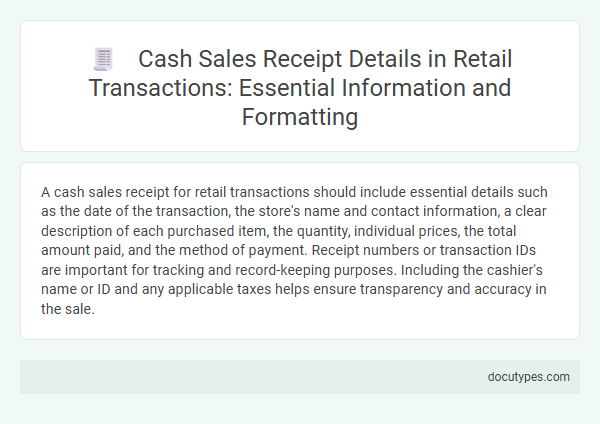A cash sales receipt for retail transactions should include essential details such as the date of the transaction, the store's name and contact information, a clear description of each purchased item, the quantity, individual prices, the total amount paid, and the method of payment. Receipt numbers or transaction IDs are important for tracking and record-keeping purposes. Including the cashier's name or ID and any applicable taxes helps ensure transparency and accuracy in the sale.
Overview of Cash Sales Receipts in Retail
A cash sales receipt is a crucial document in retail transactions that serves as proof of purchase. It records essential information related to the sale and payment made in cash.
Your receipt should include the transaction date, store name, and contact details to ensure traceability. Item descriptions, quantities, prices, and the total amount paid must also be clearly stated.
Key Components of a Retail Cash Sales Receipt
What key components should appear on a cash sales receipt for retail transactions? A retail cash sales receipt must clearly display essential details to ensure transparency and accuracy. These components help both the seller and buyer keep track of the transaction.
What specific information is crucial on a retail cash sales receipt? Your receipt should include the date of the transaction, the store's name and contact details, a unique receipt number, and a detailed list of purchased items with quantities and prices. Including tax amounts, payment method, and the total amount paid strengthens the receipt's validity.
Why is customer information important on a cash sales receipt? While not always mandatory, recording customer details such as name or membership ID can be beneficial for returns and record-keeping. This adds an extra layer of security and helps in managing post-sale services.
Essential Buyer and Seller Information
A cash sales receipt for retail transactions must include essential details to ensure clarity and proof of purchase. This information helps both parties verify the transaction accurately.
The receipt should display the seller's business name, address, and contact information clearly. It must also include the buyer's name and the transaction date. Item descriptions, quantities, prices, and the total amount paid are crucial for a complete record.
Itemized List of Purchased Products
A cash sales receipt for retail transactions must include an itemized list of purchased products for clarity and transparency. This list should detail each product's name, quantity, unit price, and total cost to help the customer verify their purchase. Clear itemization supports accurate record-keeping and simplifies returns or exchanges.
Transaction Date and Time Formatting
Accurate transaction date and time formatting is crucial on a cash sales receipt for retail transactions. Properly formatted timestamps enhance record-keeping and support customer trust.
- Use a standard date format - Display the date as YYYY-MM-DD or MM/DD/YYYY to ensure clarity and uniformity.
- Include precise time of purchase - Show hours and minutes using a 24-hour or 12-hour clock with AM/PM for accuracy.
- Position date and time prominently - Place them near the top or close to transaction details for easy reference.
Your receipt's transaction date and time formatting ultimately helps in verifying purchases and resolving disputes efficiently.
Payment Method and Total Amount
A cash sales receipt for retail transactions must clearly display the payment method to confirm how the purchase was completed. It should also show the total amount paid to provide a transparent record of the transaction for your reference.
- Payment Method - Indicates whether cash, card, or another form of payment was used, ensuring clarity for both the seller and buyer.
- Total Amount - Reflects the final sum charged, including taxes or discounts, which helps verify the accurate payment received.
- Transaction Date - Records the exact date of purchase, aiding in future returns, exchanges, or audits.
Tax and Discount Details on Receipts
A cash sales receipt for retail transactions should clearly display the tax amount, including the tax rate and total tax paid, to ensure transparency and compliance with local tax regulations. Discount details must be itemized, showing the original price, the discount percentage or amount, and the final reduced price after applying the discount. Including these specifics helps customers verify charges and supports accurate accounting and tax reporting.
Receipt Numbering and Tracking Systems
Receipt numbering and tracking systems are essential for organizing cash sales receipts in retail transactions. They enable accurate identification and easy retrieval of individual receipts.
Each receipt should feature a unique receipt number to prevent duplication and aid in auditing processes. Your system must ensure sequential numbering to maintain consistency and improve transaction tracking efficiency.
Legal Requirements for Receipt Documentation
Cash sales receipts for retail transactions must meet specific legal requirements to ensure accuracy and compliance with tax regulations. Proper documentation helps both businesses and customers maintain clear records for auditing and warranty purposes.
- Business Identification - The receipt must include the full legal name, address, and contact information of the retailer to verify the source of the transaction.
- Transaction Details - A clear itemization of purchased goods or services, including quantities, unit prices, and total amount paid, is mandatory for transparent record-keeping.
- Tax Information - The applicable sales tax rate and the total tax amount charged must be explicitly stated to comply with tax authority requirements.
What Details Should Appear on a Cash Sales Receipt for Retail Transactions? Infographic

